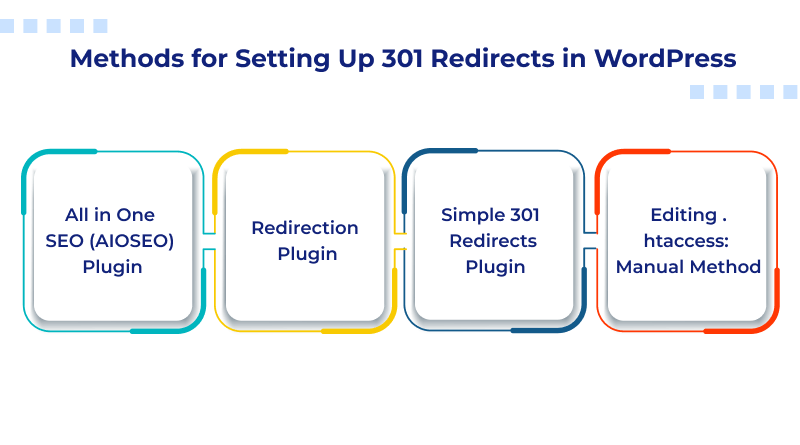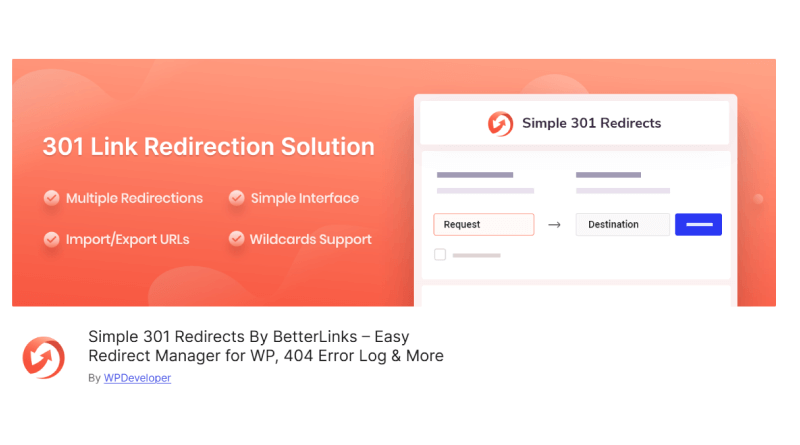Redirect in WordPress or WordPress Redirect Plugins: Does this term seem similar to you? If you host your website on WordPress hosting plans, then this is a regular SEO strategy for you. Let’s understand 301 redirects in WordPress with a simple example. Suppose you’ve just relocated to a new home. You’ve notified friends, relatives, and others about your new address, but what about all the emails that are still reaching your old address? Without a change of address form for your mail, it will be lost before reaching you.
The same applies on the internet. When you alter a URL on your site, all the previous links to it are made useless. So whenever a visitor searches for the old URL, it’s met with an infuriating “404 Page Not Found” screen. As the owner of a website, that dreaded page not only frustrates visitors, but it also ruins your SEO rankings.
The good news is, there is a quick fix that saves traffic, preserves search rankings, and makes your users smile. It’s a 301 redirect. This is the easy solution that guarantees every visitor and SEO benefit is forwarded directly to your new page.
Table Of Content
What Is a 301 Redirect in WordPress?
A 301 redirect serves as a permanent signal from the server indicating that a page has permanently changed its location. In simple terms, it tells the browser that the old URL has been modified and a new URL has been set in its place. It moves all the page traffic to a new URL and shares all the SEO merits with the new link.
It is essentially a forwarding address with the post office that guides search engines and users to the new page. If you don’t use them, you may lose engagement, backlinks, and ranking power.
When to Use a 301 Redirect in Your WordPress Site
In your WordPress site, a 301 redirect must be done in case you wish to permanently move a URL to a different location. Here are the critical cases when a 301 redirect should be done.
1. While Modifying a Page or Post URL (Slug)
This is the common use case. Consider a scenario where you gave a page or a blog post a specific permalink (the portion of the URL after the domain name) and now you wish to change it. In this case, the old URL will be a broken link. In this case, a 301 redirect will ensure that users clicking on the old link will be sent directly to the new link. This will help retain the SEO ranking and backlinks of the old page.
2. When Deleting a Page or Post
Deleting a page that has existed on your website for some time is a bad practice. If it was linked from other sites or if it is a resource in its own right, you will be creating a “404 Not Found” error. Use a 301 redirect to send users to a better page on your site if you have a similar article, a relevant category page, or even the homepage. This will help you maintain traffic and important SEO “link equity.”
3. When Migrating Your Site to HTTPS
Changing your website from the Insecure HTTP protocol to the Secure HTTPS protocol means every single URL on your site undergoes a modification. For instance, http://yourwebsite.com/page will now be https://yourwebsite.com/page. In order to maintain the old HTTP links globally, a site-wide 301 redirect should be implemented, marking the links to redirect to HTTPS. This is crucial for current-day SEO.
4. In Case You Want To Merge Multiple Pages
If there are several old, short articles you want to combine, it is advisable to create a single, well-structured and detailed piece. Subsequently, you should redirect the URLs of the old articles to the new one using 301 redirects. SEO value and traffic will be consolidated to a single page, increasing your overall ranking for that keyword.
5. When You Intend To Change Your Domain Name
This is 301 redirects on a massive scale. If you want to completely shift your website from one domain to another. For example, from oldbrand.com to newbrand.com, you have to place 301 redirects from the old domain to the new domain. This is the only way to shift traffic and domain authority.
6. When Fixing Broken Internal or External Links
Sometimes you may realize that you have a broken internal link on your website, or you see that a partner website has linked to a page on your website that no longer exists. Rather than having to personally request that they alter the link, you can simply put a 301 redirect in to redirect that traffic to the new page, thereby creating a great user experience.
Methods for Setting Up 301 Redirects in WordPress

Since you know redirects in WordPress are essential to generate a steady SEO ranking position, you must also know the top ways to perform a redirect by yourself. Whether you prefer a simple, user-friendly plugin or are comfortable with editing your website’s code, here are the primary methods for setting up 301 redirects to protect your SEO and user experience.
1. All in One SEO (AIOSEO) Plugin

This easy-to-use SEO WordPress plugin has an effective Redirection Manager (accessible in the Pro version). You need no technical expertise to use this plugin.
Steps To Use The AIOSEO Plugin
Activate Redirects: Navigate to All in One SEO → Redirects and activate redirection.
Manage Redirects: Input the source URL and target URL. Choose “301 Moved Permanently” and click on Add Redirect: You can also solve broken link problems by enabling 404 and redirect logs.
During content editing, AIOSEO tends to prompt redirect requests for URLs linking to the permalinks of the post being changed.
Related Read: Best WordPress Plugins
2. Redirection Plugin

Another plugin method is using the Redirection Plugin. This is a robust, free 301 redirect plugin and 404 error management tool.
Steps To Use The Redirection Plugin
Setup: Download the tool, activate it, and complete the setup wizard.
Add redirects: Navigate to Tools → Redirection.
Enter the source and target URL. Choose 301 and save changes.
Advanced options include URL monitoring and log maintenance.
3. Simple 301 Redirects Plugin

When you have optimized managed WordPress hosting plans, you also get an easy-to-use 1-click installer. It will allow you to install the Simple 301 Redirects Plugin. This plugin has an easy-to-follow setup process that even a beginner can follow with minimal instructions.
Steps To Use The Simple 301 Redirects Plugin
Download and activate the plugin.
Go to Settings → 301 Redirects.
Type in the old URL, indicate the new destination, and click Add New.
4. Editing .htaccess: Manual Method

Next comes the high-tech-oriented method of manually editing and redirecting in WordPress. This method is highly beneficial for the user who wants complete control over their fastest WordPress hosting server without any disruptions. Also, remember this method is suitable only for seasoned users who have technical expertise and coding knowledge.
Steps To Manually Redirect 301:
Create a backup for your .htaccess file.
Add in lines for:
- Redirect 301 /old-page/ https://www.yourwebsite.com/new-page/
- Use AIOSEO Pro’s .htaccess editor or FTP/file manager.
- Key Note: Errors in .htaccess can break your site. Only use this method if you’re comfortable with server files.
Related Read: Easy Steps To Create 301 Redirect
Best Practices for Using 301 Redirects
| Best Practice | Why It Matters | Pro Tips |
| Avoid Redirect Chains | Redirect chains (URL A → URL B → URL C) slow down page load times and dilute SEO value. | Always point old URLs directly to the final destination (A → C). Use tools like Screaming Frog to detect chains. |
| Monitor 404 Errors | Broken links hurt SEO and frustrate users. Monitoring helps you quickly fix them with redirects. | Use plugins like Redirection, AIOSEO, or Google Search Console to track 404 errors regularly. |
| Use 301s for Permanent Redirects | 301 redirects transfer SEO authority permanently, while 302/307 are only temporary and don’t always pass link juice. | Apply 301s when you move pages, change permalinks, or migrate a website. Reserve 302/307 for limited-time campaigns or testing. |
| Test Periodically | Over time, redirects can break or loop incorrectly, harming user experience. | Test URLs after implementing redirects using tools like HTTP Status Checker or browser extensions. |
| Avoid Redirect Loops | A loop happens when a URL redirects back to itself or into an endless cycle, crashing the site. | Double-check redirect rules in plugins or .htaccess to prevent infinite loops. |
| Update Internal Links | Relying on redirects for internal links slows navigation. | After setting redirects, update menus, posts, and sitemaps with the correct URLs. |
| Keep Redirects Minimal | Too many redirects increase server load and page speed issues. | Regularly audit and remove unnecessary redirects when pages are no longer needed. |
| Document Your Redirects | Without documentation, redirects can become messy and hard to manage. | Maintain a spreadsheet or use plugin logs to keep track of old-to-new URL mappings. |
Use of Redirects and Their SEO Benefits
1. Retains Link Equity (SEO Value)
With a 301 redirect, all the backlink benefits associated with the old URL are redirected to the new page. This assists in maintaining the URL’s search ranking while safeguarding its authority.
2. Restores Broken Links along with 404 Errors
Redirects resolve broken links as well as “404 Not Found” error pages. Users and search engine crawlers are seamlessly guided to the correct page, which enhances navigation and crawling.
3. Enhances User Experience
Redirects significantly reduce bounce rates along with increased engagement. This is achieved as users are guided to the appropriate content without a buffering experience.
4. Facilitates Site Migration and Redesigns
Redirects preserve SEO value while changing permalinks, moving to a new domain, or restructuring content within the site by redirecting users and search engines to the newly updated URLs.
5. Duplicates are Consolidated as a Result of Redirects
Redirects are capable of redirecting multiple versions of a single page to a single URL. This is achieved through http://example.com and https://www.example.com. As a result, the penalties of duplicate content are avoided while ranking power is consolidated.
6. Boosts Brand Credibility
Brand trust, along with professionalism, is protected through redirects by safeguarding outdated, mistyped, and alternate URLs, ensuring they all lead to the correct destination.
Ultimately, conquering the 301 redirect is bigger than a matter of not having any broken links. It’s a best practice for any serious site owner who desires to maintain their hard-won SEO clout and give each visitor a seamless experience.
Use the ease of a plugin or the power of the .htaccess file, but either way, taking this tiny action is a giant step toward a healthier, more robust website hosting experience.
FAQs
1. Is a plugin needed for 301 redirect creation on WordPress?
There are several 301 redirect plugins available on WordPress. However, they are not always needed. WordPress provides a way to create pathways for 301 redirects without plugins. However, AIOSEO and Redirection plugins do make the process a lot easier with the use of visual dashboards and automation in the background. Without them, core file edits like .htaccess are required. These are highly technical and require your coding expertise.
2. How do you enable 301 redirects without a plugin?
For seasoned users, making edits to .htaccess for Apache servers or VMG for Nginx allows the use of 301 redirects. For example:
Redirect 301 /folder/old-page/ /folder/new-page/
This method, while deceptively simple, is extremely dangerous.Due to the absence of tools to safeguard users, only those familiar with file servers should try this.
3. How does a 301 redirect help fix broken links and 404 errors?
A 301 redirect helps users and search engine bots navigate to the appropriate URL even when the links are outdated or broken. This optimizes the user experience by ensuring users do not encounter blank pages. Additionally, it protects the search rankings and SEO of the website and retains the SEO value of the backlinks associated with the outdated URL.
4. Is it necessary to set up a 301 redirect every time a URL is changed?
It is recommended to implement a 301 redirect in scenarios where the old URL is established, published, and indexed. This will ensure the flow of backlinks, users, and search engine traffic is uninterrupted. In case the old URL was never published and indexed, then no redirect will be required.








